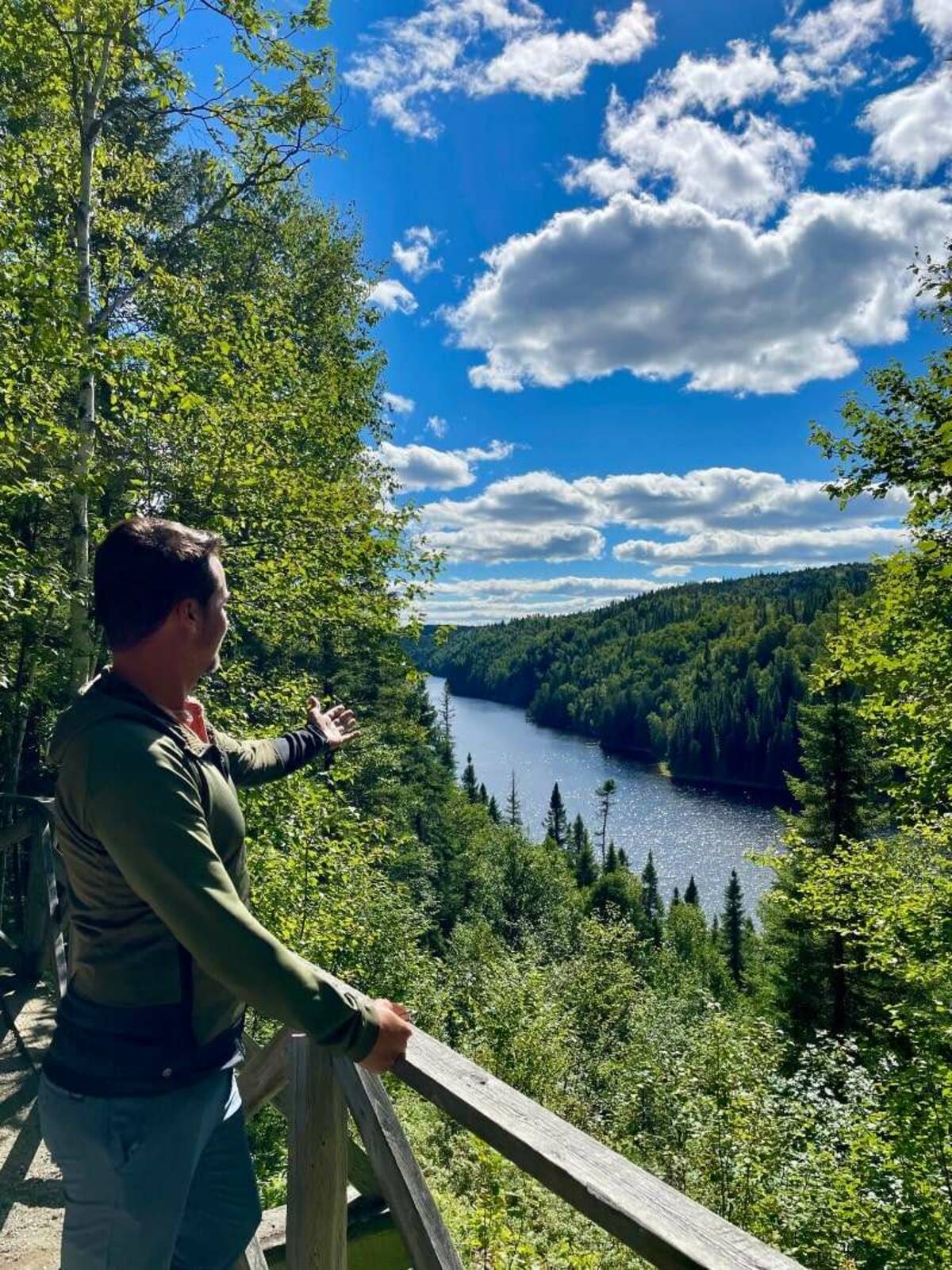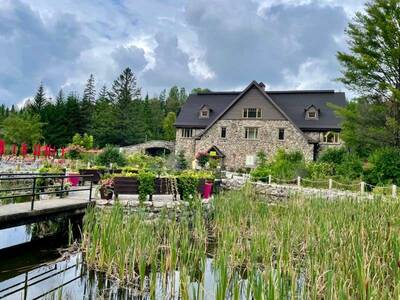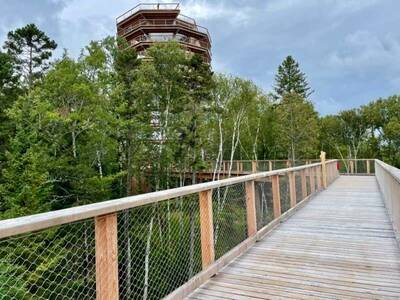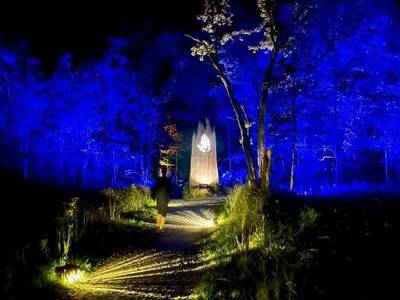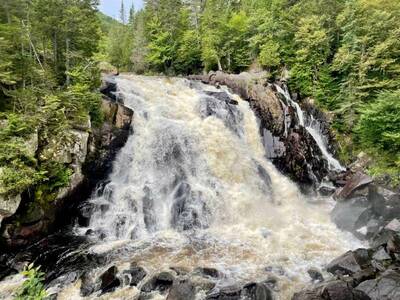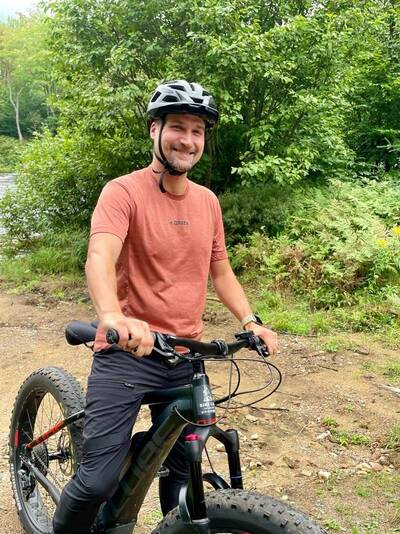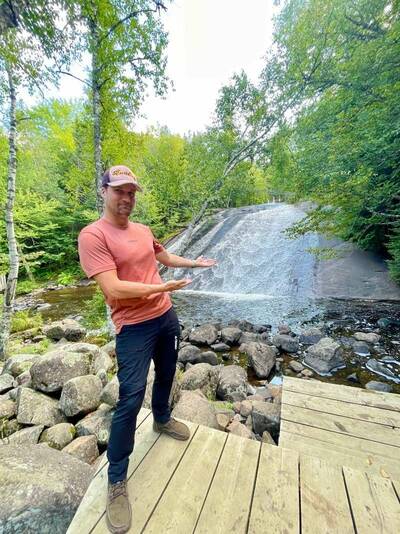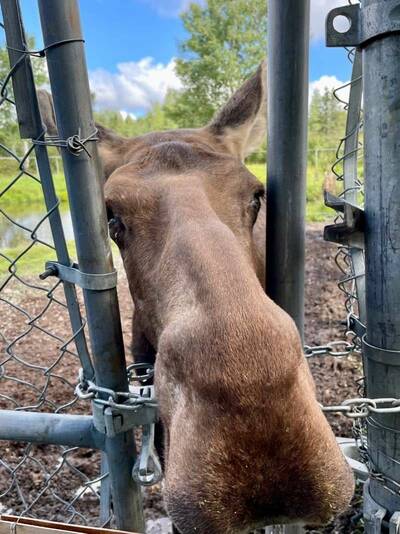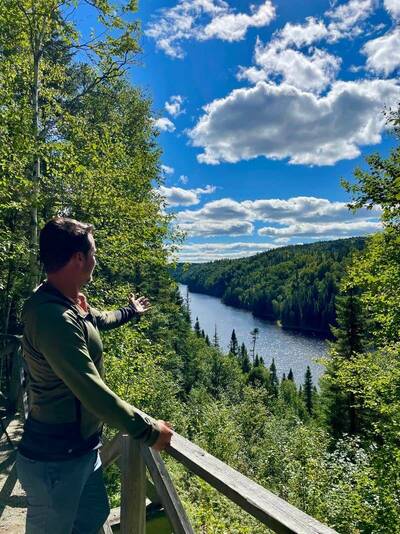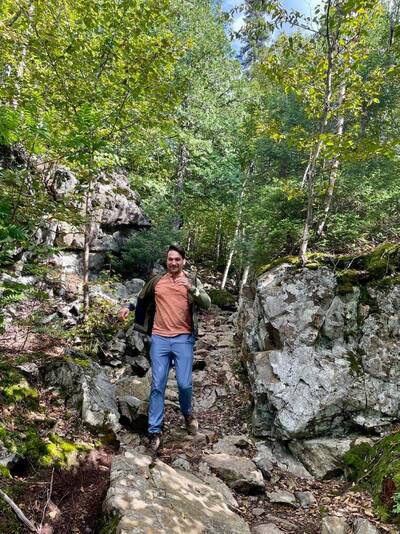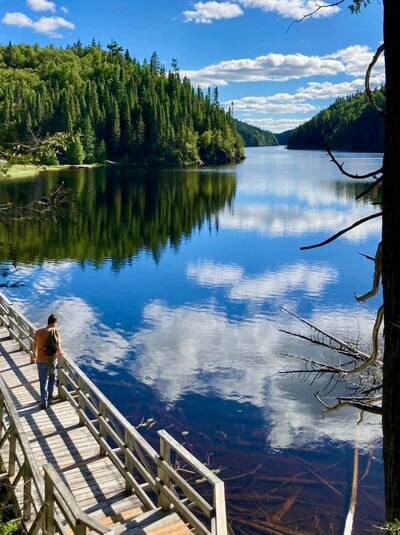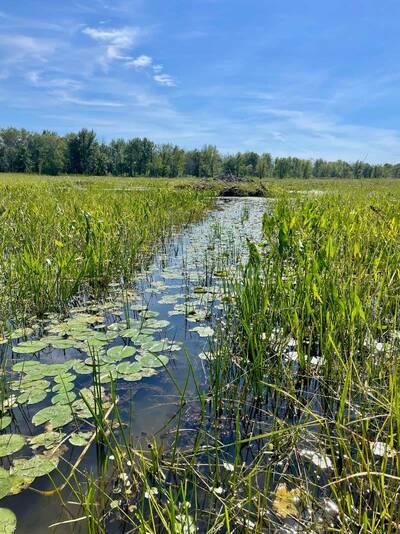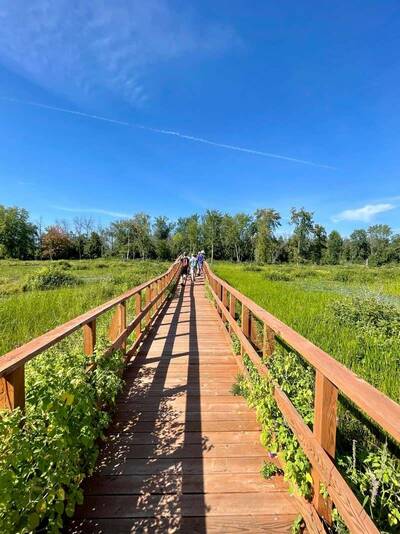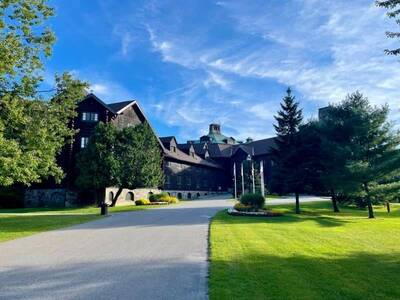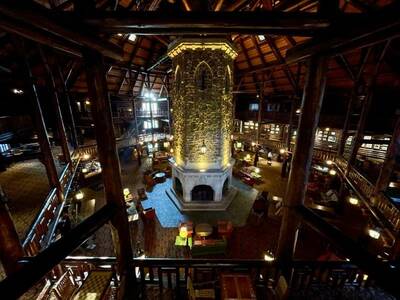This trip report covers a week-long road trip on Quebec’s Explorer’s Route. If you’ve been thinking about touring Canada but want to do more than visit one of the big cities, this route was made for you.
Hiking, backpacking, canoeing, kayaking, and bicycling are but a few of the outdoor activities you can partake in along this route. Of course, there’s plenty of culture and history to discover, but this route, in particular, will lead you on a journey to multiple national parks, outdoor recreation resorts, and remote wildernesses.
Read on to learn about my experience in Quebec and what adventures await you should you choose to visit.
Table of Contents
- Trip Report: Quebec’s Explorer’s Route Overview
- Gear Shakedown
- The Trip
- Day One: Start Your Adventure at Mont Tremblant
- Day Two: Discover the Laurentians Along Le P’tit Train du Nord
- Day Three: Journey Across the Vast Lake-Strewn Wilderness to Val d’Or
- Day Four: Find Wildlife and Wild Places in the Quebec’s Northern Reaches
- Day Five: Explore the History and Parks of Western Quebec
- Day Six: Experience the Outstanding Culture and Nature of the Outaouais Region
- Day Seven: Recuperate and Relish in Montebello’s Grandeur
- What I Would Do Differently Next Time
- Final Thoughts About Quebec’s Explorer’s Route
Trip Report: Quebec’s Explorer’s Route Overview
The Explorer’s Route is a 975-mile journey through some of Quebec’s most scenic landscapes and culturally important communities. This epic circuit is an official tourist route of Bonjour Quebec, the tourism site of the Government of Quebec.
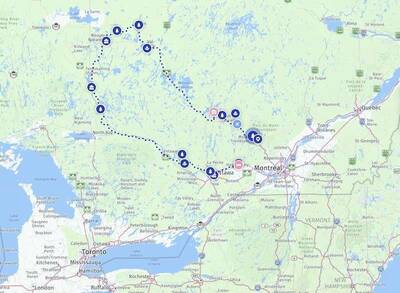
The Explorer’s Route map courtesy of Bonjour Quebec.
Though not officially attached to the route, most travelers will begin and end their journey in the beautiful city of Montreal. From there, the Explorer’s Route travels northeast along the marvelous Laurentians, across the vast and wild Abitibi-Témiscamingue territory, and through the eclectic Outaouais region.
All in all, the trip will be what you make of it as there are many options to consider. You could wander the massive wildernesses and national parks for days or weeks on end, dive into the fascinating history of the province, or indulge yourself in the richness of Quebec’s contemporary food and culture — but why not give it all a try?
Though there is much to experience along the Explorer’s Route, the following trip report will focus primarily on the area’s outdoor excursions and natural wonders. If you want to discover even more about Quebec and the Explorer’s Route, pay a visit to Bonjour Quebec.
Gear Shakedown
My journey along the Explorer’s Route was full of day hikes, kayak excursions, and national park visits. While your gear needs may vary, here’s a list of the clothing and gear that worked the best for me on this trip.
| Gear Type | Products | How It Performed |
|---|---|---|
| Boots | Versatility and comfort are the hallmarks of these boots. They can go from day hikes to dinner with ease. | |
| Sandals | You can’t wear boots all the time. These sandals were great for light hikes, water-bound activities, and relaxing. | |
| Pants | The Chubbies were excellent for short walks, water-bound activities, and relaxing. The LIVSN were ideal for longer hikes. | |
| Underwear | When you’re out there sweating each day, quality underwear is a must. Both of these types wick sweat and prevent odor, and the IBEX Naturals were very comfortable for daily wear. | |
| Shirts | The Adidas shirt was clutch for the most intense activities, while the Smartwool served as a good layering piece and sleep shirt. | |
| Socks | As far as I’m concerned, merino wool is the way to go with adventure socks. Light, tough, fast-drying, stink-free — what more do you want? | |
| Jackets | Summer in Canada can still be cold at times. The Adidas Flooce was highly versatile and comfortable, and the Micro Puff was much needed during a couple of chilly mornings. | |
| Rain Jacket | This jacket weighs next to nothing, packs down into its own pocket, is plenty breathable, and keeps the rain out. Top marks. | |
| Daypack | Accessible side and strap pockets, bounce-free hydration reservoir, and secure fit. Perfect for short hikes and trail runs. |
The Trip
Officially, Bonjour Quebec suggests that you take 9 days to travel the 975-mile Explorer’s Route. I did it in 7 days, and at the end of it all, my crew wound up driving about 1400 miles in a round trip from and to Montreal.
If you’re visiting from outside of the area, you’ll likely fly into Montreal, like I did, and start your adventure there. Simply rent a car at the airport and be on your way! Check prices and start planning your Quebec trip today with Tripadvisor.
Day One: Start Your Adventure at Mont-Tremblant
Regardless of the time of day your plane arrives and at what time you begin your Quebec adventure, it’s only a 1.5-hour drive to the mountain town of Mont-Tremblant and the adjacent national park. If you want to celebrate the start of your trip, I recommend stopping at Cidierie Lacroix for a crisp glass of De Glace cider — a deliciously sweet cider made from frozen apples (and a unique Quebecois treat!).
- Sentier des cimes.
- The observation tower hike.
Likewise, I’d also recommend stopping at the Sentier des cimes for a short half-mile hike to an observation tower with 360-degree views. This ecotourism destination is home to outstanding scenery as well as interpretive signage that’ll introduce you to some of the wildlife, topography, and history of the Laurentians. It’s a great introduction to the Explorer’s Route and what lies ahead. Plus, you can grab a fantastic meal or coffee here.
But the goal of today is to reach Mont-Tremblant. Renowned as a premier ski resort and mountain town, Mont-Tremblant is a fantastic outdoor destination year-round. The cute village and refined resort area are reason enough for a visit, but the mountain itself is an emerald gem when it’s not covered in snow with trails and activities galore.
The Tonga Lumina trail is one such unique experience you can partake in — it’s a night hike turned into a total sensory experience. The dark forest comes alive with artistic illumination and soundscapes that tell a story as you walk.
- Tonga Lumina.
- Devil’s Waterfall at Mont-Tremblant.
But if you’re looking for a more traditional outing, Parc national du Mont-Tremblant is Quebec’s oldest national park and the 6th oldest in North America. There are 6 major rivers, over 400 lakes, and many miles of trails to explore across this massive park. Lace up your boots, maybe rent a canoe, and go as deep into the wilderness as you’d like. There’s even a 17-night backcountry route you can undertake with the opportunity to stay in a different remote chalet every night!
Where I stayed: Fairmont Tremblant — There are plenty of options here, but the Fairmont is right up against the mountain. It offers ski-in-ski-out access for winter visitors, and it’s right next to all of the year-round action around Mont-Tremblant.
Day Two: Discover the Laurentians Along Le P’tit Train du Nord
The second day began with a relaxing guided e-bike ride with D-Tour from downtown Mont-Tremblant into the forest adjacent to the Devil’s River. Then, we followed Le P’tit Train du Nord — a 145-mile former railway turned bike path — north beside the Rivière-Rouge, connecting the dots from small town to small town across beautiful stretches of forested Laurentian foothills. Each town had its own history to tell, and each also had its own former train station that now had become a cafe or an art gallery or a museum — it’s wonderfully creative and adorably bucolic.
But we had a very important appointment to make. More time to explore the small towns of the Laurentians would have been great, but we had a seaplane tour to catch! Air Mont-Laurier took us up in the air above Baskatong Reservoir and the nearby lakes and forests of the Hautes-Laurentides area. The bird’s-eye view put into perspective Quebec’s immensity and how far we had already traveled away from the urban hub of Montreal.
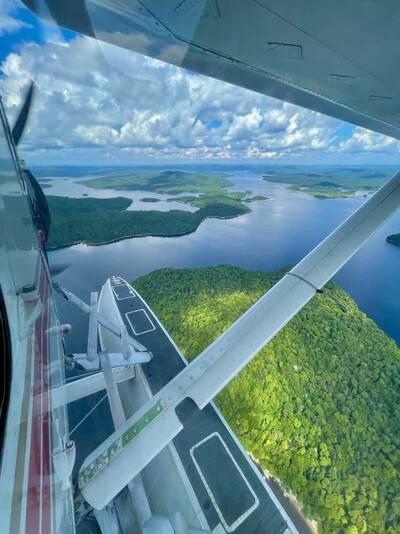
The scenic seaplane ride by Air Mont-Laurier was astounding.
Quebec is home to over three million bodies of water — that equates to 3% of the Earth’s renewable freshwater reserves. If you like water-bound recreation, then this is the place to be.
Soon after the plane ride was over, we arrived at Parc regional Montagne-du-Diable. This is another large park where you can escape into the wilderness if you so choose. There are well-appointed cabins to rent and rustic backcountry cabins you can hike to, plus there is a wide assortment of gear to rent on site, such as paddle boards, snowshoes, and kayaks.
- E-biking at Devil’s River.
- Waterfall at Montagne du Diable.
We ventured around the park and hiked to a lovely cascading waterfall, though we didn’t spend the night. Instead, we drove further into the forest to a remote lodge where hunters, fishers, and intrepid backcountry explorers prefer to set up for the night.
Where I stayed: Pourvoire Mekoos — This private property goes on for miles and is home to 134 lakes! Moose, bears, wolves, and other wildlife frequent the property. You can rent one of the on-site lakeside cabins and enjoy a meal at the lodge.
Day Three: Journey Across the Vast Lake-Strewn Wilderness to Val d’Or
This is one area I’d highly recommend spending more time in. Our troupe drove 4.5 hours straight through the Réserve faunique La Vérendrye, but you could easily spend several days here simply sightseeing, hiking, and paddling through these expansive wild lands.
Much of the reserve is protected and thus not open to recreation, but there are still trails and waterways to travel — and this is about as remote as you can get without heading to the far, far north.
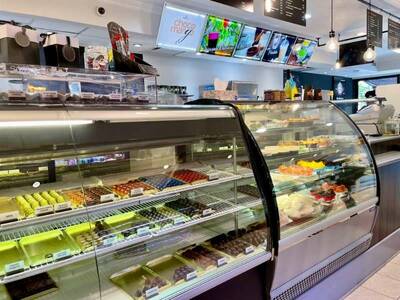
A sample of the tasty goods at Choco Mango.
Instead of recreating, we spent most of our day in Val d’Or, enjoying local treats from friendly spots like the chocolaterie and patisserie of Choco Mango. But before night settled in, we did hit the hills for mountain biking fun at Forêt récréative de Val-d’Or, which was a blast.
Where I stayed: Hôtel Forestel — A sleek hotel with great accommodations just outside of town.
Day Four: Find Wildlife and Wild Places in the Quebec’s Northern Reaches
Of all the adventurous days on this trip, this was my favorite. We started our day with a tour of Refuge Pageau, a rehabilitation oasis for animals that have been injured or are otherwise unfit to return to the wild. This place’s story is magnificent, and the work they do is incredible.
- Moose.
- Grey wolf!
At Refuge Pageau, I was amazed to see many animals I had never seen before, such as a snowy owl, grey wolves, and a piebald moose! If you enjoy seeing wildlife, you must treat yourself to a trip out here someday. There are many, many animals to see, each with a story of its own. Plus, the refuge also houses an amazing interactive digital experience about the importance of conservation and mindfulness — you’ll have to see it for yourself.
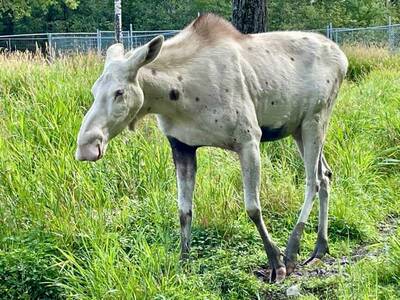
A piebald moose at Refuge Pageau. Stunning.
Later in the day, we ventured out to Parc national d’Aiguebelle. This remote, underdeveloped national park prioritizes conservation over outdoor recreation, but that doesn’t mean that there is none to be had. We hiked a couple of spectacular trails in the park. You can also rent canoes and travel from lake to lake or rent a rustic, backcountry cabin to spend the night in.
- View at Aiguebelle.
- Hiking fun.
- Lakeside trail.
If you want to escape from it all, Parc national d’Aiguebelle should be noted on your list of places to visit. Stop by the visitor’s center, or call ahead, and ask for a permit to explore the backcountry where you’re certain to not come across another human soul.
Where I stayed: La Bannik — This lakeside resort is located on the upper stretches of the Ottawa River. You can camp, rent a stationary RV, or book a loft room above the on-site restaurant.
Day Five: Explore the History and Parks of Western Quebec
If you’re into Canadian history, particularly the fur trade, you’ll want to spend some time at Obadjiwan–Fort Témiscamingue National Historic Site. There is much to see and do here, including perusing the visitor center museum, exploring the grounds of the trading post, spending time on the lakeside beach, and wandering the mysterious and enchanting “dancing” forest.
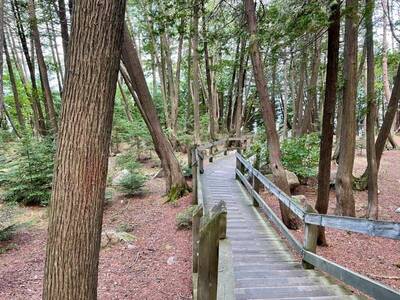
Hiking through the enchanted forest of dancing trees at Obadjiwan–Fort Témiscamingue National Historic Site.
Then, drive south alongside the Ottawa River until you reach Parc national d’Opémican — Quebec’s newest national park. There’s more to learn about the fur trade here, as well as Quebec’s logging history, colonization, and the first nation Anishnabeg. More trails are being built and beaches are being opened as the park continues to develop. Get out there now before the crowds grow because it’s not a far drive from Ottawa!
The highlight of this day, though, was a sunset canoe and kayak excursion at Parc Nature Eco-Odyssée. If you’re in the Ottawa area for any reason, this exceptional location is worth a side trip. We traversed the spellbinding water labyrinth and encountered numerous waterfowl, baby beavers, and turtles. It was a truly unforgettable experience.
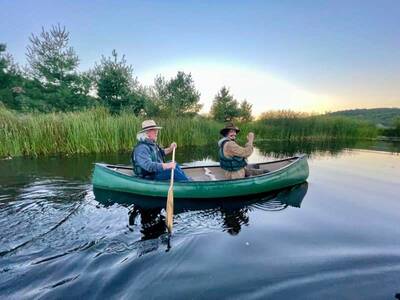
Paddling the Éco-Odyssée labyrinth with founder Michel Leclair and his son Olivier.
Plus, Eco Odyssey offers more family-friendly outdoor activities such as a walking maze, an interactive nighttime show, and child-safe archery. What’s more, the water labyrinth turns into a frozen ice skating labyrinth in the winter — how cool is that?
Where I stayed: Lofts du Village — Located in the picturesque town of Chelsea. The room was sensational. The village was charming. Be sure to grab a meal at Nikosi Bistro Pub.
Day Six: Experience the Outstanding Culture and Nature of the Outaouais Region
Chelsea reminds me of an endearing California gold mining town, one of those quaint Sierra Nevada foothill villages that comes alive on the weekends. It’s cute. It’s cool. It’s where the Ottawa locals go to have fun for the weekend.
I loved it. We went on an e-bike tour led by Nomades du Parc, a bike and paddle board shop that serves as a hub for the outdoor community in the area. Together, we pedaled our way into neighboring Gatineau Park to Champlain Lookout for an amazing view to the north from where we had driven the day prior. Then, we then cycled over to a sparkling lake before heading to lunch at the Chelsea Pub.
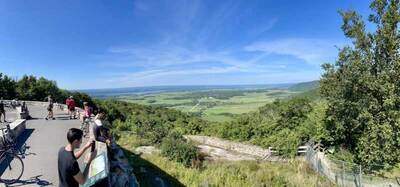
Taking in the view at Champlain Lookout in Gatineau Park.
Gatineau Park is known as a superb nordic playground, but there are also hundreds of miles of trails and paved bike paths to explore here and in the surrounding area. It’s less than an hour’s bike ride to Ottawa, so you can plan a day trip to or from the city — just grab an e-bike and go for it!
Later in the day, we walked the wetlands at Parc national de Plaisance, an ideal spot for “slow outdooring,” as the park employees liked to say. It was peaceful, but the sun was roasting us, so we sought out the shade as often as we could.
- Beaver path and dam at Parc national de Plaisance.
- Walking across wetlands.
Where I stayed: Fairmont Le Château Montebello — An upscale lodge with the face of a rustic log cabin. It was splendid.
Day Seven: Recuperate and Relish in Montebello’s Grandeur
Honestly, I wanted to spend every minute I had in the chateau. The grounds were amazing, and the interior was breathtaking.
- The Fairmont Le Château Montebello.
- The interior.
However, this last day was a short one. After breakfast, our party drove over to Kenauk Nature. It’s the largest private nature reserve in North America. At over 160 square miles in size, it’s more than twice the size of Paris.
We paddled across one of the many lakes on the property. This private reserve has multiple private, off-grid chalets to rent, each one with its own private lake to enjoy — talk about serenity. If I get the chance, I’m coming back here to see all that Kenauk has to offer.

The tranquility of Kenauk Nature was invigorating. It was a great send-off.
But if only every trip could last longer, for it was time to depart. After a beautiful midday adventure in Kenauk, it was off to the airport to return home.
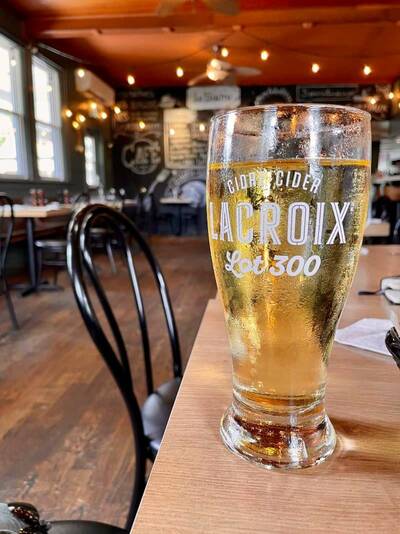
This trip began with a Lacroix cider, and so it ended with one as well. Cheers Quebec! Santé!
What I Would Do Differently Next Time
Time. More time. As stated earlier, we completed this trip in 7 days. Bonjour Quebec recommends 9 days, and I’d say you should take a full 2 weeks to give yourself the time you need to sink into some of the destinations along this epic road trip.
There’s so much to see and do. The entire experience was great, if too short, but this road trip gave me a good idea of where I’d return to when I come back. And oh yes, I’m going to return.
Final Thoughts About Quebec’s Explorer’s Route
The Explorer’s Route is a tale of two themes: nature and history. The trip showcases these throughout its entire course. There is a seemingly endless expanse of nature to explore and equally as much history to uncover.
You may plan for and undertake this trip for the sights you’ll see, the food you’ll eat, or the pure thrill of adventure — but know this, it’s the people that I’ll remember most of all.
Quebec’s landscapes are gorgeous, the outdoor activities are fun and numerous, and the food is great. The people, too, are special. They’re warm, welcoming, and adventurous, and their spirit is what will stick with me the most — they’re what I will remember first when I think of my time in Quebec.
Are you interested in planning a trip like this? Start planning your next adventure with Tripadvisor.
Backpackers.com Affiliate Policy: This article may contain affiliate links, which help fund our website. When you click on the links to purchase the gear we get a commission, and this goes a long way to creating guides, gear reviews, and other excellent content.
